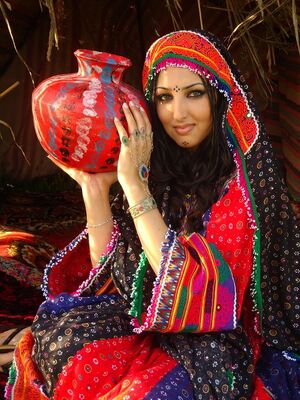Chitral
| Author:Laxman Burdak, IFS (Retd.) |

Chitral (चितराल) or Chetrar (Urdu: چترال) (Khowar:چھترار) (Persian: چیترال), is the capital of the Chitral District, situated on the western bank of the Kunar River (also called Chitral River), in Pakistan.
Chitral (Pashto: چترال) is one the 24 districts in the Khyber Pakhtunkhwa Province of Pakistan. The district was formed in 1969.
Location
The town is at the foot of Tirich Mir, the highest peak of the Hindu Kush, 25,289 ft (7,708 m) high. Chitral district is situated in Malakand Division, lying along the Afghanistan border. It is connected with the Dir District via the Lowari Pass.
Access to Chitral
The easiest access to Chitral is in the southwest along the Chitral or Kunar Valley towards Jalalabad. This route is open all year and provides direct access to Kabul. However the Pakistan–Afghanistan border (Durand Line) prevents this being used as an internal route to Peshawar and the south.
History
Buddhist and Hindu period - Chitral was a Hindu country before the extension of Islam, and traces of Buddhism[1] are also found.[9]
H. W. Bellew writes that The Sakarauloi of Herodotus are by some supposed to be represented by the modern Sarikoli, but a preferable identification is obtained by reading Sakatauroi instead of Sakarauloi ; we should then have on the east of Baktria the great and powerful Kataur or Kator nation, which established contemporary branch dynasties at Kabul and in Kashmir, and which is at this day represented in Afghanistan by the Shah-Kator princes of Chitral and Kashkar. [2]
H. W. Bellew writes that Katar, or Kator, is the same people as the Katoran or Katorman, who established a Turk dynasty which ruled contemporaneously in two branches at Kabul and Peshawar respectively, from the beginning of the fifth to the latter part of the ninth century, when, after losing much of their power and territory to the Tuar Rajput kings of Delhi, they were finally overthrown by them and the Ghaznavis. Under the rule of the Kator Yuechi (Getai or Jata) Buddhism was the religion of the country, but during the century or so of Tuar Rajput sovereignty, Brahminism was the dominant religion, till the Hindu was finally dispossessed by Sabaktagin, who founded the Ghaznavi Turk dynasty. The Shah Katori of Kashkar and Chitral, who, as above suggested, represent the Sakarauloi of Strabo, are the same people as the Katar of Kafiristan, the name of which country was formerly Kator ; at least in the time of Tamerlane, the beginning of the fifteenth century. [3]
The Kator (or Katoar or Kataria or Kshatriya), the Kotol or Kitolo of the Chinese or Kedara or Katorman of Abu Rehan or Cidaritae or White Huns of Priscus, are none else but Yueh-Chih. [4]
People
- Khoshey - The majority of the population in this area are Khoshey (Khosa Jat clan). The main tribe, the Khow, speak Khowar (or Chitrali), one of the Dardic languages, which is also spoken in parts of Yasin, Gilgit, Ghizer and Swat. Pashto language is also spoken and understood by some in the city.
- Katurey - The ruling class is Katurey (Katar Jat clan) ancient Chitrali tribe speaking Khowar.
- Kalash tribe - Very ancient people of the period of Mahabharata. Chitral is known for the famous Kalash tribe polytheist native inhabitants that ruled the region for centuries later invaded by "Khow". The Kalasha reside in an enclave of three remote valleys west of Ayun, which is ten miles down from Chitral town. The Chitral culture is Islamic and contrasts considerably with the urban cities of Pakistan as well as the adjacent district of Gilgit. Women are nearly invisible except to their male relatives and other women. They avoid walking the streets of the town, so men or children do most of the shopping. Travel requires the company of a close male relative and sometimes the wearing of a burqa. There is also a sizeable population of Nuristanis, Tajiks and Uzbeks most of whom arrived from Afghanistan in the late 1980s.
Population
Further reading
- Decker, D. Kendall (1992). Languages of Chitral.
- Durand, Col. A. (1899). The Making of a frontier.
- Leitner, G. W. (First Reprint 1978). Dardistan in 1866, 1886 and 1893: Being An Account of the History, Religions, Customs, Legends, Fables and Songs of Gilgit, Chilas, Kandia (Gabrial) Yasin, Chitral, Hunza, Nagyr and other parts of the Hindukush, as also a supplement to the second edition of The Hunza and Nagyr Handbook. And An Epitome of Part III of the author’s The Languages and Races of Dardistan. New Delhi: Manjusri Publishing House.
References
- ↑ The Afghans By Willem Vogelsang Edition: illustrated Published by Wiley-Blackwell, 2002 Page 184 ISBN 0-631-19841-5, ISBN 978-0-631-19841-3
- ↑ An Inquiry Into the Ethnography of Afghanistan By H. W. Bellew, The Oriental University Institute, Woking, 1891, p.142
- ↑ An Inquiry Into the Ethnography of Afghanistan By H. W. Bellew, The Oriental University Institute, Woking, 1891, p.146
- ↑ The Jats:Their Origin, Antiquity and Migrations, by Hukum Singh Panwar (Pauria) p.325

